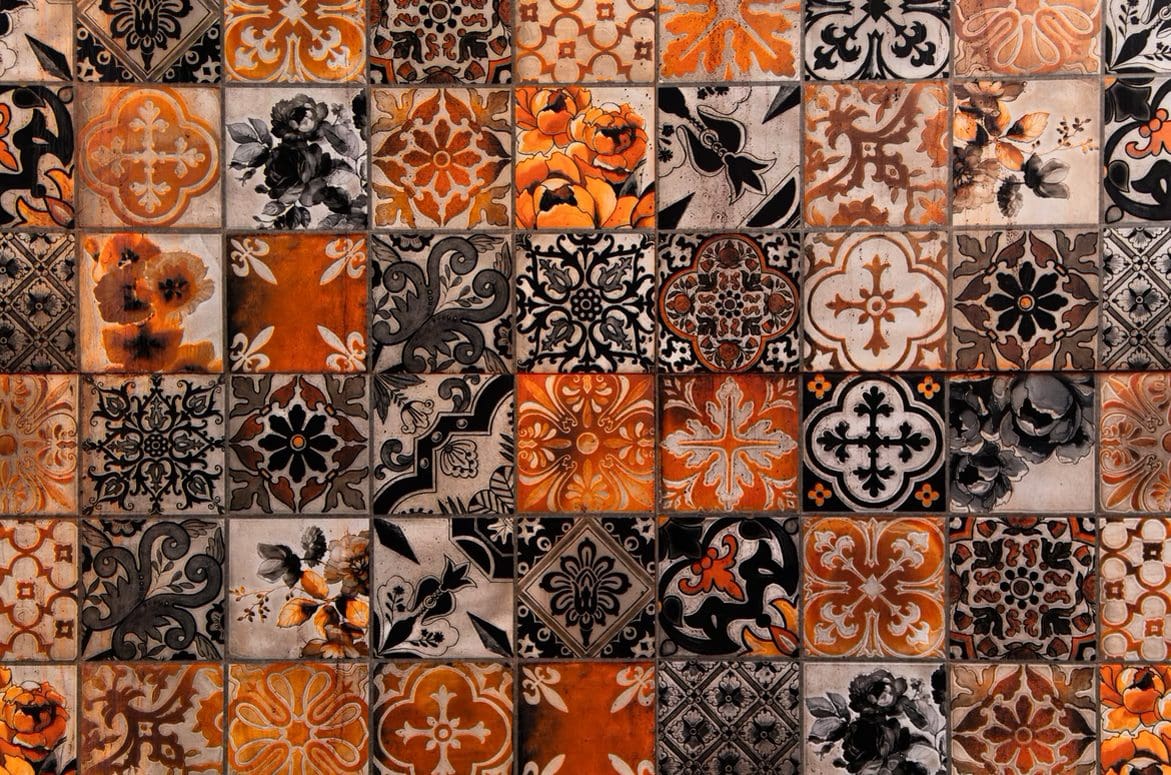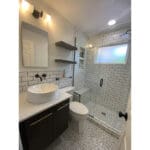The Definitive Guide to Tile
Author: Thomas Borcherding | Updated On:
Everything You’ll Ever Need To Know About Tile
Tile makes up one of the largest expenses in a home remodel. All of those dollars per square feet add up quickly, especially in large areas. Once it’s installed, it’s there to stay for decades. To remove an entire tile job necessitates the removal of the waterproofing membrane to which the tile is adhered. That is to say that you’ll have to strip the wall down to the point where the studs are exposed. This creates the expense of not only additional tile, but new waterproofing membrane as well as labor. This is why we stress the importance of making the right decision when it comes to selecting the tile for your project. In this article we dive into the history of tile, the different types of tiles, various tile definitions, and design tips on selecting the right tiles.
What Is Tile?
To classify as a tile, a slab of material such as baked clay, stone, metal, concrete, or other materials must be used as a covering. What a tile may cover includes things such as walls, roofs, and floors. The concept of a tile does not exclude curved or irregularly shaped materials. A good example of a curved tile is a terracotta roof, in which clay is molded and then fired into a U-shape. Tile will have to be held in place with a fastener known as mortar, which is applied to the back of the tile and adheres the tile to the area intended to be covered by the tile.
Tiles can also take the form of a mosaic. A mosaic is a pattern or image composed of small and/or irregular tiles intended to be decorative or convey a meaning. In a residential setting, mosaics are most commonly found as part of the backsplash seated behind a gas or electric cooktop. Mosaics are also commonly found in bathroom shower enclosures, sometimes within a shower niche.

The History Of Tile
It may come as no surprise to some that the earliest evidence of tile comes from Ancient Egypt, dating to the fifth millennium, or 5000, BC. Their technological milestone took the form of an alkaline glaze on quartz stone. Egyptian stoneware was widely exported in the ancient world, and has been found in Mesopotamia, around the Mediterranean and even in northern Europe.
Throughout history, tiles produced in small quantities and were reserved for royalty as well as places of religious worship. Come the Victorian era and the industrial revolution during the 1800s, tile finally came to public fruition as it began to be mass-produced. One of the most impactful figures when it came to bringing tiles to the public was Herbert Minton. Herbert, based in England, developed a factory that by the 1840s mass produced floor tiles, paving the way for the tile industry.
Types Of Tiles, How They’re Made, Pros And Cons
Ceramic Tile:
Ceramic tile has been, and continues to be, the most popular form of tile. While the classical definition of ceramic includes porcelain and brick, the contemporary use of the phrase ceramic tile is markedly distinguishable from both porcelain and brick. In today’s world, a ceramic tile will be made with a coarse clay of varying quality and fired at a temperature of no more than 1,650 degrees Fahrenheit.
Ingredients vary by manufacturer, but other additives can include sand, feldspar, and quartz. This type of tile is the most budget-friendly. However, it can also be the most expensive among your options should you find yourself looking at high-quality handmade ceramic tiles. Builder-grade, budget-friendly ceramic tile will run around $3 per square foot. Mid-scale ceramic tile costs around $5 to $6 per square foot, and upscale ceramic tile can cost upwards of $10 per square foot. These prices do not factor in the price of labor.
Ceramic tile has found itself as the most popular form of tile due to its low cost and incredible durability. There do exist low-quality ceramic tiles out there that will have a high probability of cracking and chipping just on install alone. For something that will last multiple decades, it is worth spending a little extra to get the higher quality option.
Another appeal that ceramic tile has is its ability to be printed on as well as have a glaze applied to it. These options give ceramic a stylish innuendo. A tile’s style will go out of date long before the tile itself will. This is due to ceramic’s ability to withstand large amounts of force as well as withstand moisture. However, ceramic does not withstand moisture as well as its cousin porcelain does.
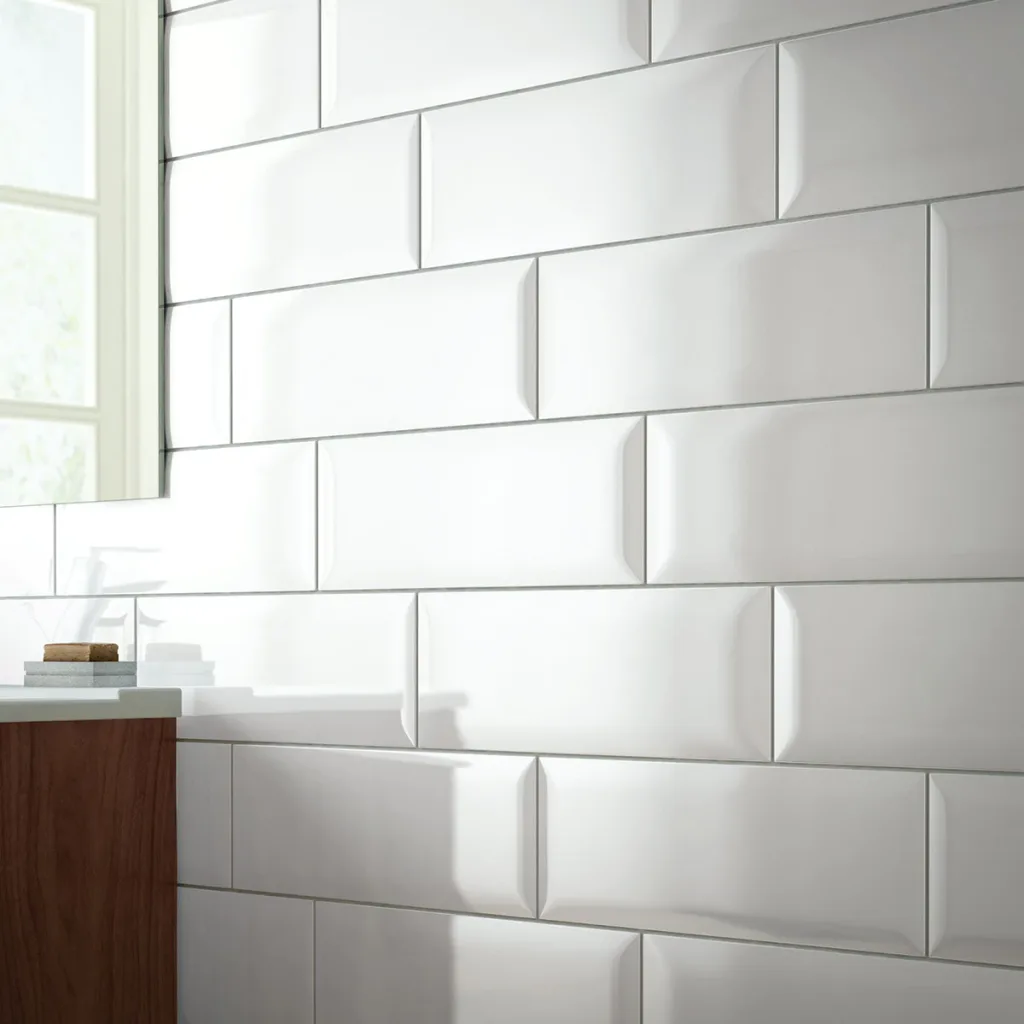
Porcelain Tile:
Porcelain tile is very similar to ceramic tile but has some key differences. The major difference between ceramic and porcelain is the difference in water absorption. Porcelain carries the category of “impervious.” To be classified as impervious requires a water absorption rate of less than 0.5% of the tile’s mass. To achieve such a feat, porcelain makes use of large amounts of feldspar, white clay, kaolin, and quartz.
The shaped clay then gets heated in a kiln at an astonishing temperature of around 2,400 degrees Fahrenheit, almost 1,000 degrees more than standard ceramic tiles get heated. The crystalline structures of the ingredients alongside the high temperature bake form a material known as porcelain that is superior to ceramic in almost every way.
Porcelain is denser, tougher, and less porous than ceramic tile. As you may have guessed, it will also carry a higher price tag than ceramic. Expect to pay around $5 for lower tier porcelain and $10 to $25 for upscale porcelain, per square foot. The price is not unjustified. You can plan on porcelain lasting longer than ceramic due to its higher density and water resistance making it more durable. Manufacturers have developed processes that have allowed porcelain to mimic marble as well as wood, making for a great alternative to these materials.
Cons to porcelain includes its exceptional sharpness when broken. Extra care needs to be taken when dealing with porcelain scraps and shards. Porcelain is also a very heavy material and is not DIY-friendly due to its heavy weight, but also because it can be hard to cut. Its high density can make it hard for an inexperienced tile-worker to saw or snap the tile. This high density can lead to chips in the tiles when attempting to cut them should the wrong techniques be used. Aside from that, porcelain is a fantastic material and is particularly useful in high traffic areas due to its durability.
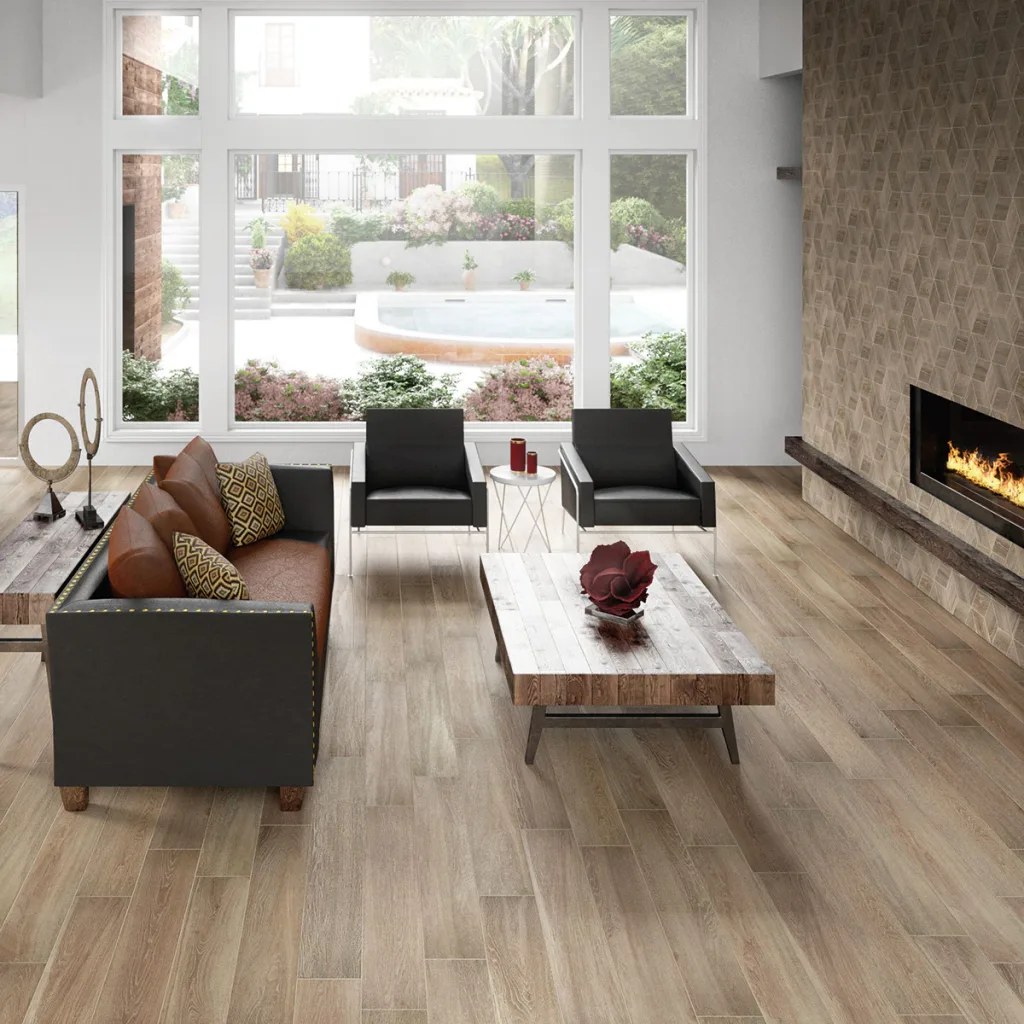
Cement Tile:
In the 1850s is when cement tiles made their first appearance. They offered an amazing alternative to ceramic tiles that at the time reigned supreme. Cement tiles have been growing in popularity recently as people have started to love the beautiful colors and designs featured on the top layer of the tile. Cement tiles are composed of the same type of cement that is used to manufacture concrete, while also mixing in sand and marble powder.
The composition is mixed and then placed in the desired shape’s mold, and subsequently hydraulically pressed using 1,500 PSI and left to cure. There is no firing involved when fabricating cement tiles. Cement tiles will not feature glazes due to their lack of firing.
Cement tiles will last decades and feature extreme durability if proper care is taken. The top layer of the tile, where the mineral pigments used to create the visible design, is naturally porous and needs to be sealed. Cement tiles should be sealed after installation, and periodically depending on the sealer manufacturer’s instructions, typically every three to ten years.
It is this porous characteristic that can result in cement tiles propensity to stain should the tiles not be sealed properly. Cement tiles can be obtained typically for $10 per square foot. While not as maintenance free as ceramic or porcelain tile, cement offers a unique solution to your tiling needs.
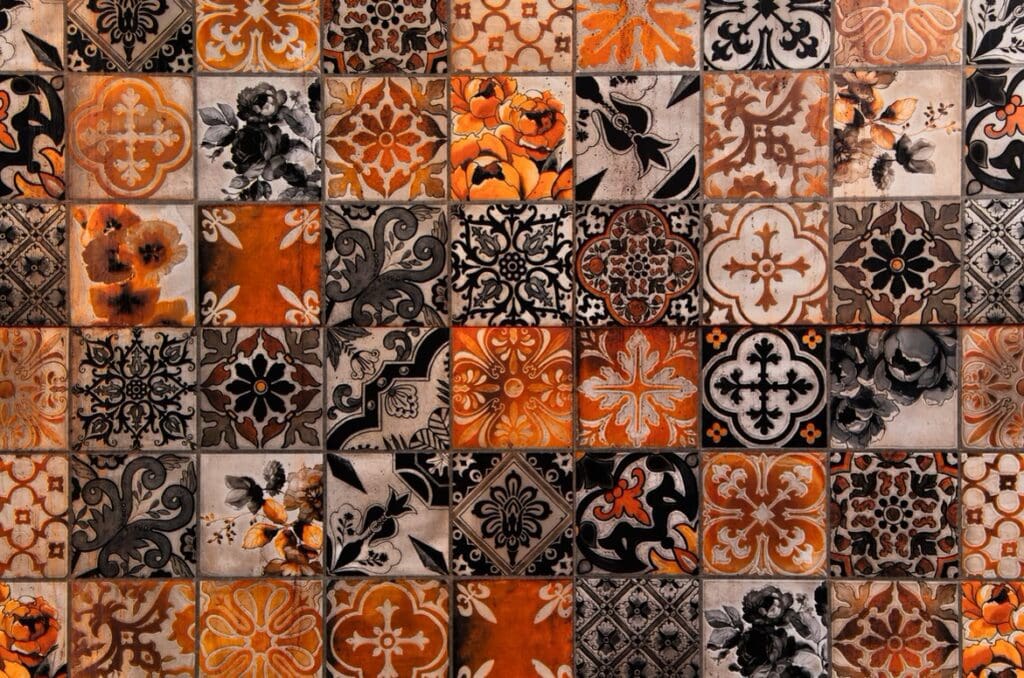
Marble Tile:
Marble forms when limestone or dolomite are subjected to extreme pressure and heart, morphing the original rock into a stone known as marble. Marble’s reputation precedes it. Commonly known as the most beautiful and luxurious stone available for building products, marble is often associated with exorbitant costs to homeowners. Contrary to popular belief, marble tile is a very feasible tile when it comes to budgeting.
You can expect to obtain marble tile for around $5 to $15 per square foot. There do exist higher quality and rarer cuts that can reach upwards of $65 per square foot, typically intended to be used as a mosaic as opposed to simply wall or floor tile. Marble can last a lifetime, if not two, when properly cared for.
Marble has high maintenance requirements. It must be specifically cleaned with a non-acidic cleaner, otherwise the surface can be etched by the acidic cleaner. Marble tile must be sealed regularly. Expect to seal your marble every 6 months to a year if your tile has a matte finish to it with exposed pores. If your marble is polished down to a smooth finish, you may be able to get away with sealing the tile less often. Be sure to clean spills immediately as acidic food or products can stain the tile.
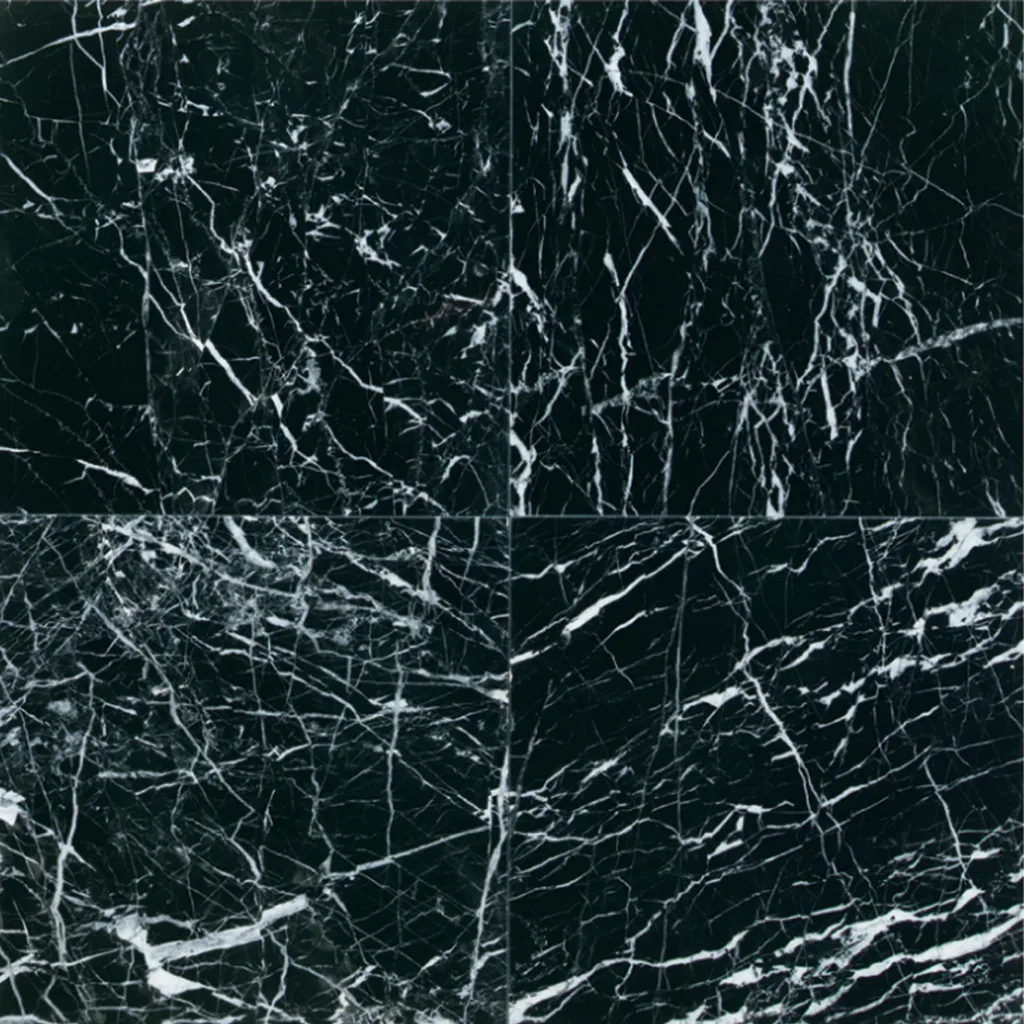
Travertine Tile:
Travertine is a naturally occurring stone, created by the solidification of calcium carbonate materials found in fresh water, typically springs, rivers, and lakes. Travertine is classified as a variety of limestone. In order to create a tile out of the stone, a quarry operation must be setup and the tiles cut out of slabs harvested from the quarry. Travertine will run a buyer roughly $3 per square foot, minimum. This makes it an affordable option.
The stone is one of the most popular stones used in modern architecture. Its swirls of color caused by mineral deposits create a beautiful presentation. The stone is extremely porous due to gases traveling through it as it forms underwater, and is consequently rough due to the holes present throughout. This creates a pro and a con.
The rough surface in non-polished tiles creates an amazing non-slip texture to prevent falls in slippery conditions. If not sealed correctly, travertine will allow moisture to travel through it and cause damage if not cared for. Travertine can be effectively sealed using a proper sealant, but we still advise the use of a high quality waterproofing underlayment system as well.
The rough surface paired with the porousness of the stone make it a great paver to use outdoors. Water will not accumulate for long on top of the stone, and the rough texture makes for excellent traction. Fortunately, methods do exist that allow for the stone to be polished into a smoother surface. This can allow the stone to be used when it otherwise wouldn’t, such as for kitchen flooring. Overall, travertine is a very beautiful stone that deserves a spot in homes. The maintenance on the stone is high unless used outdoors. In exchange for properly being cared for, travertine tile will offer you decades of longevity.
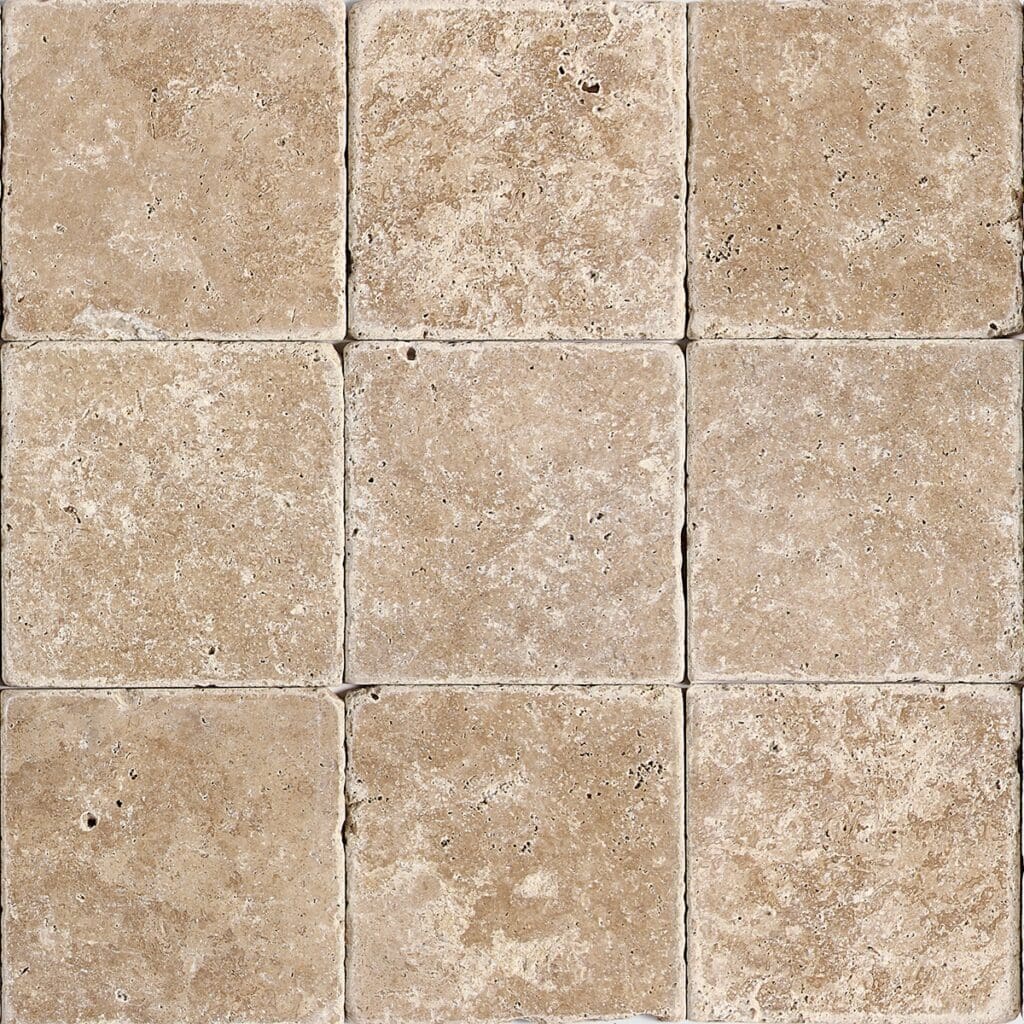
Limestone Tile:
While travertine is a type of limestone, limestone is not necessarily travertine. Limestone is a rock formation composed mostly of calcite and aragonite. Limestone is a natural stone, whereas tiles such as ceramic, concrete, and porcelain are artificial. Limestone’s popularity comes from its light and earthy appearance. Additionally, each cut of limestone is unique due to its natural formation.
Limestone is slightly less hard than marble, hovering around a 3 on the Moh’s hardness scale. The stone can be scratched relatively easily, and is typically not recommended in high traffic areas. For this reason limestone has become increasingly used for kitchen backsplashes and other wall tile applications. A common trend among tile manufacturers is to powder and then mix limestone with other stones such as travertine and marble.
Nevertheless, limestone is a very popular tile choice and fetches prices around $7 to $15 per square foot. Like most of the other natural stone options, limestone is porous and has to be sealed upon installation and then regularly after. The stone is a great choice for any project, has been used for millennia, and will continue to be as the stone’s popularity shows no sign of slowing down.

Granite Tile:
When you think of granite, the first thing that comes to mind is probably countertops. There is no reason that granite needs to be restricted to just countertops though! Granite is a natural stone mostly comprised of feldspar, mica, and quartz. It has been a common building product throughout history due to its overall strength and resilience. In fact, the granite industry is one of the oldest industries, dating back to Ancient Egypt.
Like most natural stones, granite has to be sealed correctly. This makes the stone resistant to stains, but not stain-proof. Granite is a very hard stone, ranging from 6-8 in the Moh’s hardness scale. This makes it perfect for high-traffic areas, or areas that take a lot of abuse. The price per square foot for granite ranges anywhere from $5 to $15.
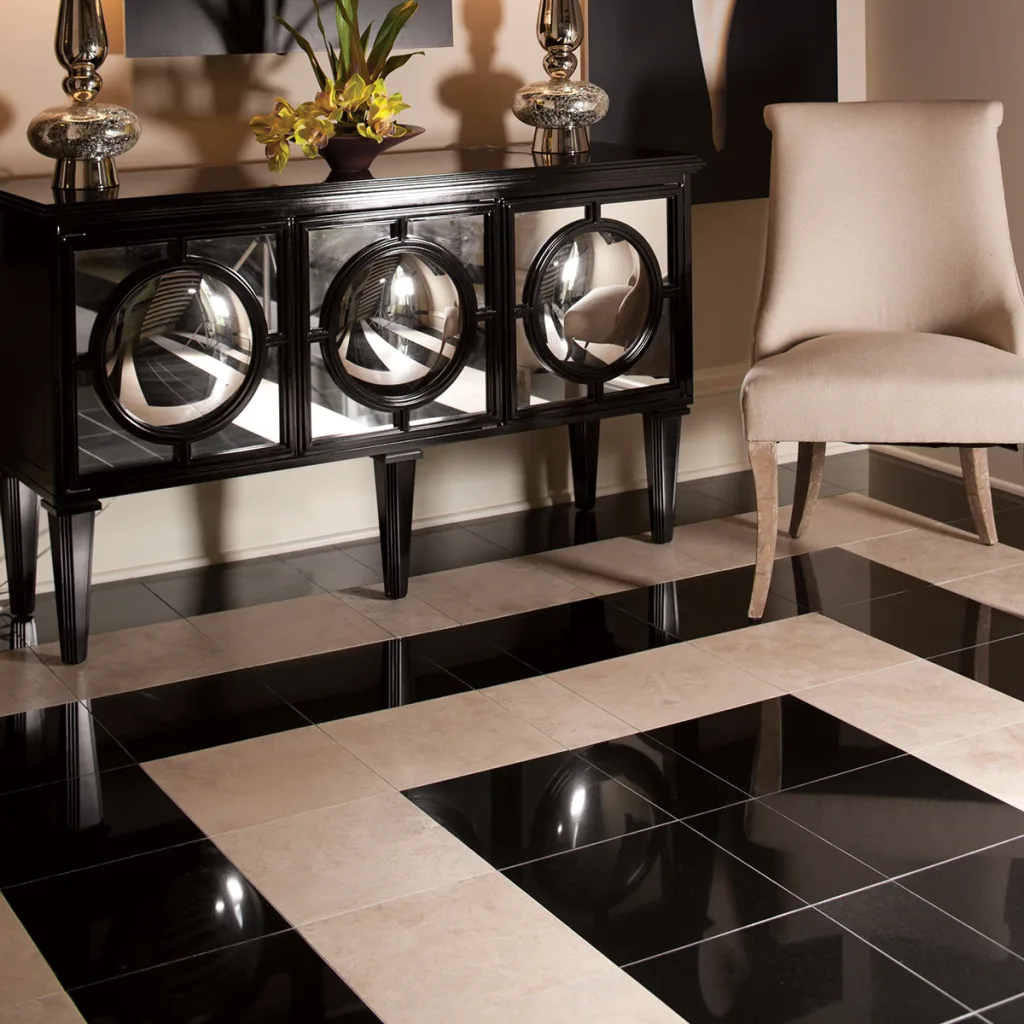
Glass Tile:
Glass tiles have been growing in popularity due to their recognized use of imparting intense colors to any given space, as well as the ability to refract light, brightening the area. Glass tile is close to perfect when it comes to being resistant to stains, mold, and mildew. To achieve the color and design on the back of glass tiles, color pigments are placed on a protective coating which are then placed on the backside of the glass.
Most glass tile’s are manufactured for wall and mosaic usage. Never use glass tile as flooring unless the manufacturer has indicated it is safe to do so. Glass tile is quite expensive, typically ranging from $10 to $25 per square foot. The success of glass tile installation heavily weighs on the quality of the installer. Due to its fragility, glass tile has to be installed by a true professional.
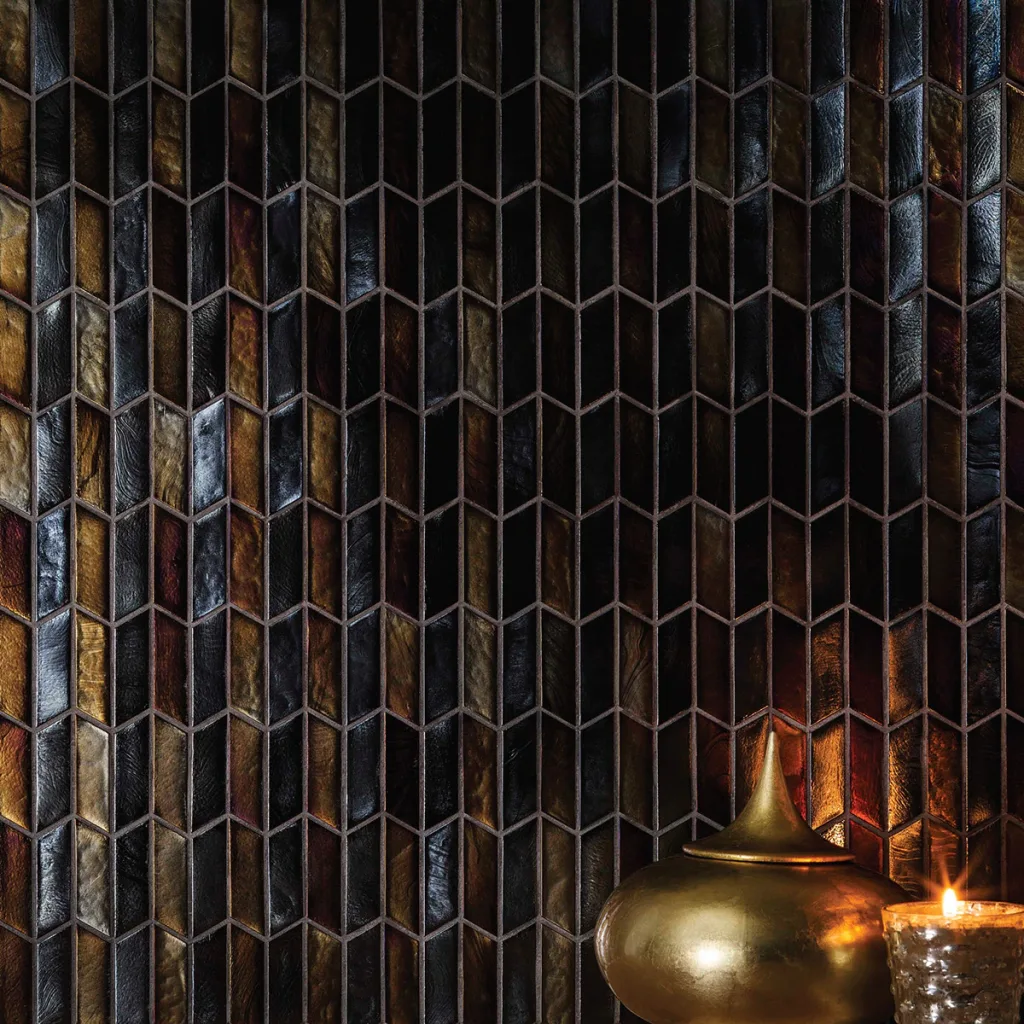
Slate Tile:
Slate is yet another naturally occurring stone with particularly impressive water absorption metrics, with the rock absorbing no more than 0.4% of its mass in water. This is less than even porcelain. For this reason, slate has found one of its primary uses as being made into roofing shingles. Slate rings in at 2.5 to 4 on Moh’s hardness scale, making it the softest stone we have had the pleasure of writing about in this article.
Older, but sometimes even new, slate tiles have a tendency to flake. If flaking does occur, it is not the end of the world as slate’s color carries itself through to the back of the tile. Slate is a porous stone and like most other natural tile options must be sealed. Ensure that spills are cleaned immediately and that no acidic cleaning products are used on the stone. Slate tiles will normally be darker in nature, with some beautiful earth tone colors being showcased, such as rich blue, dark reds, and vibrant oranges. Slate is a very budget friendly tile, obtainable for around $2 to $5.
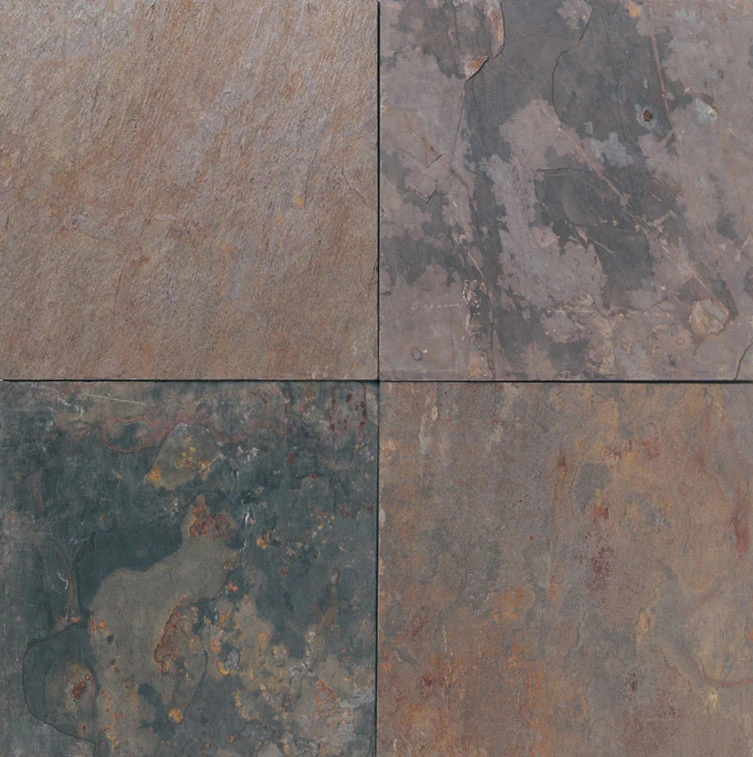
Which Tile Is Right For Me?
In order to select the right tile for your, you must first decide how to narrow down your choices. We suggest starting with determining how important maintenance is to you. Naturally occurring, porous stones will require the greatest maintenance. The tiles that require the greatest amount of maintenance include slate, limestone, travertine, cement, marble, and granite. However, it is important to note that maintenance only entails sealing the stone regularly as well as wiping up spills immediately.
The tiles that require the least amount of maintenance include ceramic, porcelain, and glass. Porcelain is a personal favorite of ours due to its hardness, extreme resistance to moisture, as well as its ability to be made into almost any look, even carpeting or wood. After deciding on whether a tile that requires maintenance is right for you or not, it’s best to try to find a tile that will carry with it a style that works with the final style of your desired room. For instance, if you are going for a rustic feel, then a slate tile may be what’s right for you.
About the Author

Thomas Borcherding is a professional kitchen & bath designer, and a member of the National Kitchen & Bath Association (NKBA). He is the second-generation owner of Homestar Design Remodel, and takes great joy in providing those in St. Louis with high-quality, affordable home remodeling.

